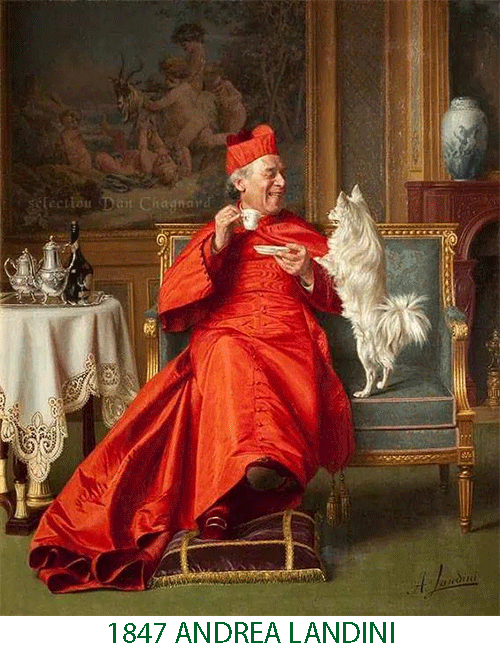
MASTERS PAINTINGS & OLD PHOTOS SPEAK FOR THEMSELVES

HISTORY
History and Requirements of the Volpino Italiano
VOLPINO ITALIANO
Volpino means "Little Fox"
Other names include the Italian Pomeranian, the Italian Spitz dog, the Florentine Spitz
(cane de Firenze), the Volpino or Vulpino Romano,
Cane del Quirinale, Romano & Quirinale refer to the ancient Roman roots.
The Greek name from 400bc is Melitan
Victorian authors have also used the term ‘
lupette’ or ‘lupetties’- meaning small wolf –
WHAT IS A VOLPINO?
Don't be fooled, if you see or have a little white dog that looks like one of these
Volpino's but you were told it was an American Eskimo, then either you don't know
the History or the Breeder does not know the history or the breeder is hiding the
truth. Breeders went to Italy, bought a Volpino, brought them back to America, changed the name to, Toy American Eskimo. As time went by they did breed them to the American Eskimo so we don't know if the small Toy sizes are mixed or pure.
Volpino's are a type of Spitz in it's morphology and character, and dates back to 350BC.
The Maximum Height is 33cm (11 to 13 inches),
uni-color white or red. It's coat has long, straight glassy, raised wavy hair around the
dog like a muff.
It broke away from the common stock of the European Spitz dogs
and has spread through out Italy since ancient times.
It was taken into lordly houses. The Volpino was loved by palace lords as well as farm

The Volpino in Italy was the choice pet of the women of Italy. The Volpino Italiano was adorned with bracelets and collars, made of ivory as a symbol of the owner's love. The Volpino Italiano was the most popular breed for Italian royalty for centuries.
Specimens from this group have been found preserved in European peat bogs which anthropologists trace to 2500 BC.
The remains-with curly tails, foxy heads and small erect ears-have been found dating back over 5,000 years.
Despite the Volpino Italiano's popularity in the past, today the breed was not known outside of Italy but it's known that Volpino's were brought to America for many years during the turn of the century and shown as Pomeranian's.
In Italy it still remains in small numbers. Engravings of similar dogs were found in Greece, and these have been determined to date about 350 BC.
BRIEF HISTORICAL SUMMARY - So the Volpino goes back to the same ancestors as the German Spitz of which he is not a descendant, but a relative. He has been bred in Italy since immemorial times and has been idolized in the palaces of noblemen as well as in the hovels of the common people where he was especially appreciated because of his instinct of guarding and viligence. The Volpino was the dog of Micheangelo. Michelangelo painted his Volpino's in many of his paintings.

In the 18th century, the tireless companion of the carters of Tuscany and Latium.
Always ready to announce noisily any strange persons met on the
roads. The Italian word for wolf is Lupo.
The Keeshond is called both Lupino and Volpino in Italian. So Volpino's may be an old term for wolf dog or wolf Spitz, (small fox).
The Volpino was loved by palace lords as well as farm and plebeian quarters, especially in Tuscany and Lazio. For unexplained reason but we do have our theories, with some newspaper articles backing them up, the numbers of this population declined continuously until it came near extinction.
In Italy, 1965 only five subjects were registered in the Breed Book alive. Then it disappeared until 1984 when Enrico Franceschetti and the ENCI launched a recovery project for Italian breeds. Then, precisely those dogs that had survived on rural farms, being used to rouse the more powerful watch dogs, were the new progenitors of the modern day.
Today the situation is continuously improving, even though the red variety seems to be rare and the black is found in rural country-sides of Italy but not recognized by the ENCI as yet. The Volpino has a reactive temperament attached to the family and wary of strangers. It has a strong watch dog instinct robust and lively, this dog is long-lived.
The exact origin of the Volpino Italiano is not known, although this breed resembles the Italian Pomeranian which it is impossible for this breed to have descended from the Pomeranian because the Volpino is a much older breed.






